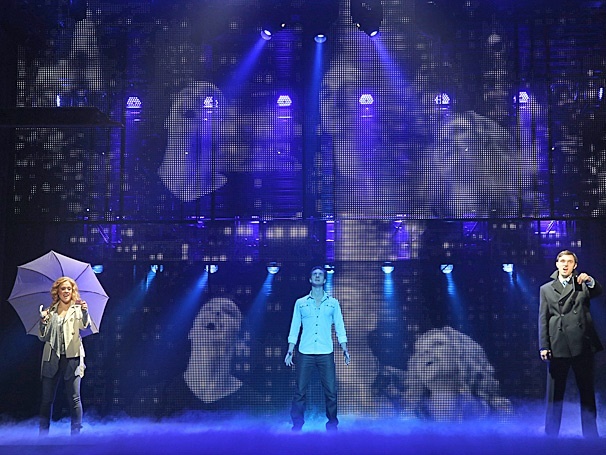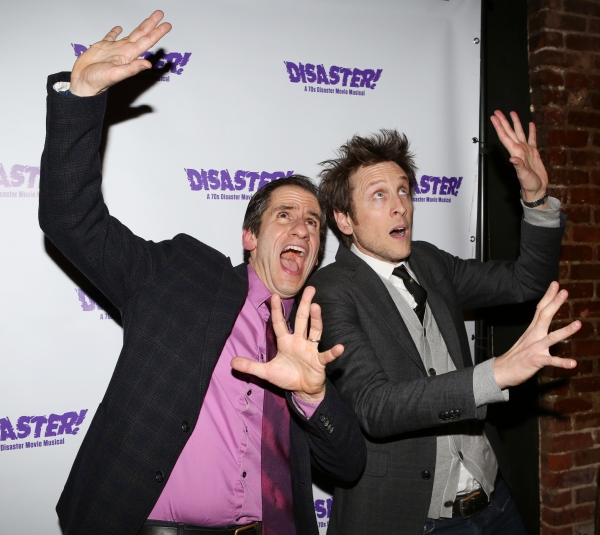Katie Postotnik, Steven Grant Douglas & Robbi Haltiwanger
in Ghost the Musical. Photo-Joan Marcus
Ghost the Musical
Book by Bruce Jay Rubin, based on his screenplay
Music & lyrics by Dave Stewart & Glen Ballard
Directed by Matthew Warchus
Review by Kathi E. B. Ellis
Entire contents copyright © 2014 by Kathi E.B. Ellis. All rights reserved.
Ghost the Musical inhabits the Kentucky Center for the Arts this week. The storyline exhibits a rigorous fidelity to that of the movie, which is not always satisfactory within a theatrical context – and even when the book does deviate from the movie the theatricality is not enhanced. Originally helmed by some impressive names, Matthew Warchus (director) with music and lyrics by Dave Stewart and Glen Ballard, the production was more successful in London than on Broadway, where it ran for five months, in 2012 before turning to the tour circuit.
This company is energetic and throws itself into the high-octane music and movement with verve. But therein lies an inherent conflict with the original story – while the stage version mirrors the arc of the movie, it misses the tone and tenor of the wistful low-key journey of Molly (Katie Postotnik) and Sam (Steven Grant Douglas) through his death. This version also amps up the raucousness and (broad) humor of Oda Mae (Carla R. Stewart) and her sisters’ psychic business. There is a chronological disconnect; the music and choreography (Ashley Warren, with Liam Steel credited for Additional Movement Sequences) seem drawn from the late 80’s/early 90’s time frame of the movie, suggesting the style of that period’s music videos, while the ubiquitous use of contemporary mobile phones, and selfies, push us awkwardly into the 21st century.
As with last season’s Flashdance, the use of projections and screens seems to be a favored operandus for translating a movie to a stage. In Flashdance the iconic bridges and factories of Pittsburgh were at the core of the storytelling, almost another character in the story. Here, Ghost is a more universal story – love and loss does not only happen in New York City – and the aggressive verisimilitude of NY streets, traffic, subways, etc. streaking and zooming on the many moving parts of the scenery frequently push the characters onto the periphery. The Tony-nominated design elements (lighting – Hugh Vanstone and video and production – Jon Driscoll), scenic design (only associate scenic designer Paul Weimer is credited in the tour program) and illusions by Paul Kieve frequently overwhelm the very human story being told. As impressive as is the first train sequence, and it is impressive, the sequence has the effect of putting the story on hold while the viewers are swept up by the technology.
Much more theatrically interesting are the movement and tableaux sequences of walking, meeting, greeting, kissing, and embracing that are interspersed throughout the production. These create the busy people of the city, the fact that individual love and loss are ignored or are anonymous; and these sequences would stand alone, without the technology, to suggest the City. Beyond that most of the choreography is superimposed onto the story rather than integrated into it. With the exception of ‘Unchained Melody’ most of the musical numbers are generically ‘poppy’ with no single one rising out of the group. The sequence that is most successful in blending technology, music, and staging is Subway Ghost’s ‘Focus’ in which he shows Sam how to move substantial matter. This scene creates the illusion of items moving propelled by the energy of the two ghosts – Brandon Curry’s Subway Ghost is excellent – and it succeeds because here is a balance between the performances and the technology allowing the storytelling to thrive. A brief moment towards the end of the evening demonstrates how delicate an illusion can be and hold two thousand people in thrall.
The story, of course, centers on Molly and Sam. Ms. Postotnik’s Molly is one-dimensional and never rises to the intensity of someone grieving so much for their soul mate that they would take the risk of reaching out to the ghost of their lover. At Tuesday’s opening her voice did not have the warmth to enrich the ballads nor the fullness to sustain the belts. Mr. Douglas’ Sam grew on me as the story’s pace intensified. The role of Sam is not well served in script or staging, making him much more passive and more of an observer than in the movie. Nonetheless by act two Sam’s palpable desperation and desire to protect Molly shines through and helps propel the story to the inevitable parting of Molly and Sam.
Ms. Stewart is in the unenviable position of recreating a role that Whoopi Goldberg and Tony-nominated D’Avina Joy Randolph originally created on screen and on Broadway respectively. And she does so with aplomb. Ms. Stewart revels in the broader aspects of the way in which the role is written, and also finds some nuggets of compassion and vulnerability that make Oda Mae a believable conspirator in Sam’s quest. In particular the scene in which Oda Mae permits Sam to inhabit her body for a last moment with Molly is haunting, with both Ms. Stewart and Mr. Douglas embodying the strength of ‘the love inside’. This scene quickly morphs into Carl Bruner’s death, and is another scene in which the illusions and the actors are on equal footing and, though different from the movie, plays effectively within a stage convention. Robby Haltiwanger’s Carl suitably morphs from innocuous best friend to betrayer to desperate adventurer throughout the evening
For audience members who bring with them fond memories of the 1990 movie with Patrick Swayze, Demi Moore, and Whoopi Goldberg, they will find a mostly-familiar story on stage. The iconic movie scene of Molly and Sam at the potter’s wheel is inexplicably moved into a somewhat creepy post-death moment, while the original love scene is recreated, coyly, with the introduction of images of their intertwined bodies on a swiftly-lowered screen as the characters sink onto a couch. The movie runs at less than two hours; this production clocks in at well over two (even given a late start and an intermission that dragged beyond the posted length). I’m not convinced that the additional time in telling this story through music and dance heightens the emotional stakes of the original.
Ghost the Musical
March 11 – 16, 2014
PNC’s Broadway in Louisville
Kentucky Center for the Arts
501 West Main Street
Louisville, KY 40202
502-584-7777
kentuckycenter.org





